A conversation with Doug Vitarelli

Surrounded by the tobacco fields that for decades produced Topstones, one of the world’s greatest cigars, is Dean Lennert’s animation studio which for decades has been producing another quality product, the animated film “Dear Anna Olson.”
Dean began his career as an animator while a student at NYU at Broadcast Arts doing fabrication, rigging and special effects for stop motion animation. After graduation he worked at Rafik’s, the cheapest place in town for video duplication and film supplies, before getting his “sad little” resume together and, walking uptown from Battery Park, dropped it off at every animation studio listed in the ‘yellow book’. A chance meeting in a midtown elevator with his SVA animation teacher, Jeffrey Gatrall, led to a freelance job at the Ink Tank, which then led to bigger gigs at Jumbo Pictures, working on DOUG, J. J. Sedelmaier Productions, BEAVIS AND BUTT-HEAD, and Blue Sky, ICE AGE and BUNNY.
It was while working at J.J.’s, in ‘95 that he began to teach at NYU. When offered a second class a few years later he decided to accept it and moved out of the city.
These days Dean is the head of NYU’s animation area and this interview was a fun reminder of NYC’s vibrant animation scene in the 90’s and 00’s. Our meeting revealed that, even though we have many similarities, (both animators, married to a Nancy, same age, taught together at NYU and a love for the work of Frédéric Back) we never actually sat down and had an extended conversation.
Strange. Well, not as strange as the way the interview began…
“Hold on a second. There may be a bear in the backyard,” as his dogs began to bark.
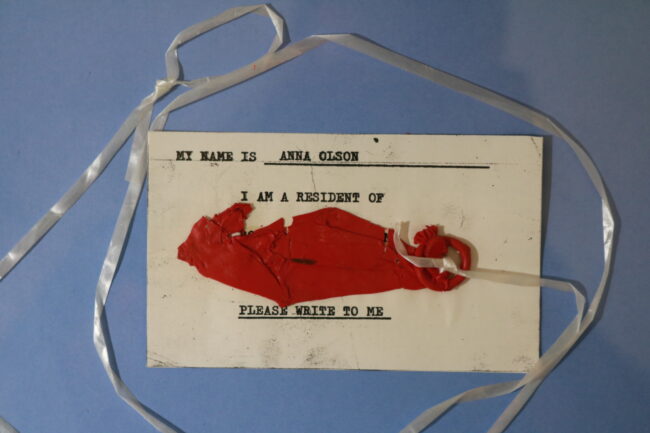
So I want to start with what (animator and ASIFA-East board member) Ray Kosarin told me, that you used to work at Rafik’s and started this film while working there?
Yeah, the film started in 1989.
But the inspiration for the project goes back to 1987 when I found a note tied to a balloon caught up in a tree near my hometown of Ellenville, NY. The note said, “My name is Anna Olson” It included her mailing address of the nursing home where she was a resident and ended with “Please Write to me.”
I did write to her and sent holiday cards for that first year but never received a reply. I found out later that it wasn’t uncommon for nursing homes to send out notes tied to balloons for residents who didn’t have family or at least didn’t have family who visited with any regularity.
By the way, due to the risks posed to both aquatic and terrestrial animals, I would highly discourage anyone from sending notes out tied to balloons (or even releasing the balloons themselves), whimsical though it may be.
How do you keep this fire going and continue to do it?
The answer is simply that I feel a good story is a gift and the opportunity to tell that story shouldn’t be squandered. And as Anna’s story seems to resonate with so many people, many of whom are supporters of the project, it would be a shame not to be able to share the completed film with at least them.
The other secret is keeping (or at least trying to keep) a regular weekly work schedule on the film. This practice of having a work/art balance goes back to my teenage years when I started to make my own films but also worked at the family business, which was a gas station. I was very serious about my art and filmmaking and my parents recognized my passion and supported me but there were conflicts where, many times when I had a shoot scheduled, I’d be called in last-minute to (work at) the gas station when some employee didn’t show up. This became so chronic that I resorted to marking the dates I had scheduled shoots on the calendar at the station and had my dad initial them.
And then, sure enough, the next time I had a shoot, my dad calls, “You need to come in.” To which I replied, “Look at the calendar.” He then responded, “All right.” and hung up the phone. There was always some tension over this but I feel that he respected my dedication and, more importantly, I got the time for my films!
After I graduated from NYU, and left the structure a university setting provides, this work/art balance became even more important if I wanted to continue working on my own films, especially in the early days of being a freelancer with all of the chaos that brings to one’s schedule. This is when I began dedicating alternating nights and weekends to working on Dear Anna Olson.
As I started to generate some completed shots, I began bringing volunteers onto the project during the “Animation Weekends” to assist with inking and coloring while I continued animating. Since I was still relatively fresh out of NYU at this time, many of these volunteers were students from the Animation Area. I would cover their subway fare, provide home cooked meals (a big incentive for any college student) and in the evenings we would hangout, eat popcorn and watch 16mm prints of films that I’d get from the Brooklyn Public Library. This practice continued throughout my professional career until Nancy and I moved up to Connecticut.
With being full time at NYU since 2002, I have been able to dedicate two to three full days to the film each week and the Summer Breaks allow for large uninterrupted blocks of time. Although, it can be a challenge when one is working at home (“Wait, did I remember to move the clothes from the washer to the dryer?”). And over the last few years, between my fundraising efforts and squirreling away some of my pay, I have been able to hire a small crew of two to three artists for about 10 weeks over the summer.
In short: maintaining a regular and consistent schedule is a very important part of any creative endeavor. In my book, it’s far more important than inspiration, which tends to be very fleeting.
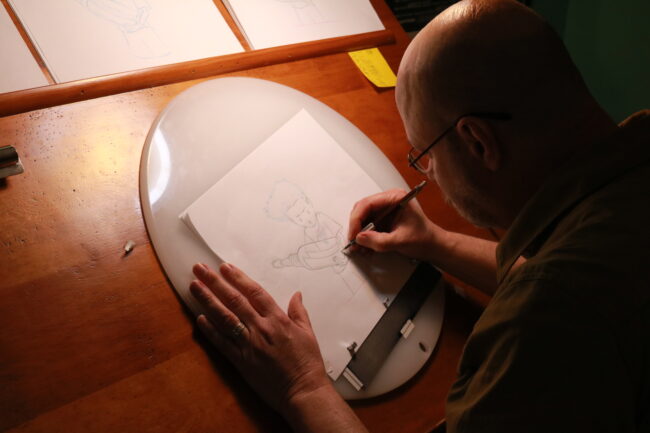
You’ve been working on the same project for 35 years?
35 years in June.
Do you find that some people just don’t understand this passion?
That doesn’t really seem to be a problem since many of the important people in my life at the moment are fellow artists or have been directly involved with the creation of Dear Anna Olson in one way or another.
My producer, for instance, Jennifer Kirby, has been working with me since ‘93. We met through a mutual friend, Steve Akehurst, who was a regular volunteer on the film in the early days, and she was interested in being a producer on the project. I was really excited to have somebody willing to handle the budgetary and the fundraising end of things.
I remember in the early ‘00 we got together at one point and she said, “I can’t do the fundraising anymore, you have to do it.” This was a bit of a shock as I liked being the crazy person in the back room while she was in charge of the front office.
She’s your Roy.
Yeah, and when Jenn broke this news to me, I didn’t know if I wanted to vomit or what because the idea of approaching somebody and asking for money to support my art is terrifying! But she said “They don’t want to speak to me. They look at me as the business person, they want to speak with the artist.”
I’m still not completely comfortable with handling the fundraising end of things, although it’s much easier than it was. But Jenn knew the importance of this and we really started bringing in some substantial funding almost immediately. This allowed me to stop freelancing and dedicate more time to the film. I attribute this new success of building enthusiasm for the project to the fact that, when I talk about it, I get (what I jokingly refer to as) ‘crazy eyes’.
I can see that. You’re being very Italian, speaking with your hands a lot right now.
Yeah, when I talk about the film (what inspired it, the themes it explores, etc.) people, regardless of their connection with animation specifically or the arts in general, they feel a connection with Anna’s story. And, perhaps, my enthusiasm for the project is a bit contagious. Who knows?

So when any of us work on a film, the more we work on it, the better we get. For instance, when you started Beavis and Butt-Head you were not nearly as good as when you finished, right? So when you started Dear Anna Olson I’m guessing there’s not one drawing from the first five years that’s still going to be in it. I could be wrong.
No, everything’s in it.
Okay. Wow, excellent!
Yeah, the way I approached the animation was a bit of good luck. I started out with the nursing home scenes which fit with my skill set at the time. The characters were all elderly (mostly) and moved around slowly so I could handle that. The next sequence was with the Woodsman who was kind of this big lumbering character – also not a lot of movement. So, basically by the time I got to the later scenes with the kid, who is high energy, I was prepared to tackle that.
Later in the production, I began to jump around to different sequences, which required me to adjust my skill level so that there weren’t any quality shifts from one shot to another. For example, the last shots from the film were animated in 2019 (30 years after the production started) and took place with the characters in the nursing home so I had to study the first shots I animated for the film and think like 24 year old Dean Lennert instead of the 54 year old version.
I attribute much of the success for being able to pull this off to having spent four years at J.J. Sedelmaier Productions where I learned to be an animation chameleon. You see, the studio didn’t have what you would call an ‘in-house’ style. Instead, J.J. would work with many different designers and illustrators for the projects he directed. This meant, and I say this only half-jokingly, that we would discuss a project in our morning production meetings and then have to be drawing like that designer by noon.
So, again, nothing has been ditched from the film and there are no ‘scenes of shame’ in it. In some ways, it’s almost like a visual autobiography charting my growth as an artist. And, especially now that we’re well into coloring the final production art, I’m getting more excited about what the completed film is going to look like. I find that my energy is getting perpetually renewed as we hit each phase of production.
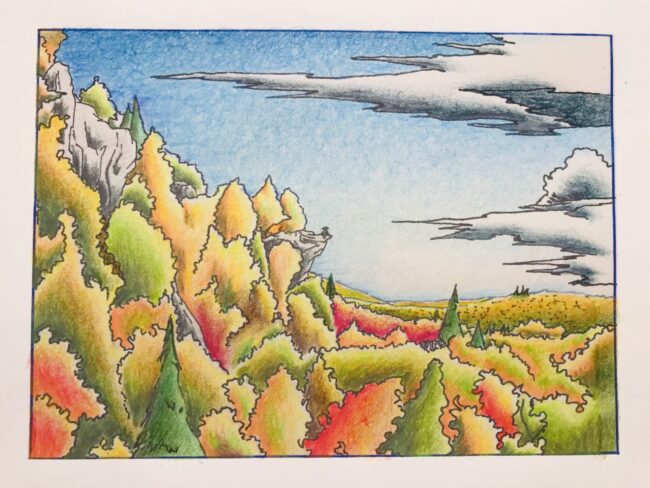
You told me the original idea was that the story could have been told in three minutes but now it’s 16-minutes. So how did that happen?
I had a very basic storyboard but it has kind of grown and changed as we added characters and expanded the story. Much of this has been driven by my professional experiences where, due to schedules, budgets or simply meeting the brief on any given assignment, you have limits on things you can try or ideas you’d like to explore. With a personal piece like Dear Anna Olson, one can go down as many rabbit holes as one would like until you’re satisfied with the level of quality of each shot. I’m not saying that every shot has the best animation but I can say that I pushed myself to my own personal limits during the process of realizing them. But now that everything is locked (more or less) there won’t be any changes to the number of shots or the shots themselves.
Any second thoughts on maybe you should change to all digital. Do you use Toon Boom or something?
No. Never! A matter of fact, when I was working at Blue Sky I was animating one shot where the balloons are all drifting above the city and I have the cityscape drifting and rotating away as we are ascending with the balloons. My friend at Blue Sky Studios, Steve Talkowski, was looking at me hand-animating this stuff and he said, “You know, you can just set up a bunch of shapes and animate it that way and then print it out.” I said, “Yeah but that’s not what this is about. This is about me animating it.”
Up until recently I was still going to try to shoot the whole thing on film.
That was my next question.
So about everything up through the first act and a half and some stuff towards the end have been shot on film so, that’s going to be transferred to a digital medium. But the rest of the artwork is going to be scanned and prepped in Photoshop and then composited in After Effects. And I’m sure we can put a little grain pass on it to match the film footage.
I don’t think you’re going to need one.
Yeah. With the texture of the paper, I don’t think too many people will detect it.

And what about audio?
Taking inspiration from one of my favorite films, Crac! by Frédéric Back, I chose not to have any dialogue or narration in an effort to make Dear Anna Olson more accessible internationally. The soundtrack is going to be a combination of a musical score with a naturalistic sound design. I already have a composer, Cory Gabel, who has already written some musical sketches of the film’s theme, and a sound design team who are very interested in the project.
As I would like to avoid using sound effects libraries if at all possible, I began making my own recordings for the film. For one of the very early recording sessions we did go into a nursing home just to record ambient sound. I then purchased a DAT recorder and, over the years, have been recording a lot of effect and ambient sound. I’m hoping this will bring an added level of authenticity to the film.
Speaking of which, and as an example of going down a rabbit hole, there’s a sequence with Ravens in the film and I was listening to a story on NPR where an ornithologist was talking about Ravens having accents. So I called my producer and asked if she could call the Ornithology Department at Cornell and ask them if they have any raven recordings from the area represented in the film?
When she reached out to them, they responded, “We don’t know what you’re talking about.”
And Jenn said, “Well, ravens have accents.”
To which they replied, “What?”
“Well, my director just heard this on NPR. They were interviewing an ornithologist saying that ravens, depending on which region they come from, have different accents. He’s doing a film that takes place in the Shawangunk Mountains” and they said, “We’ll send you some recordings but they’re probably not from there.”
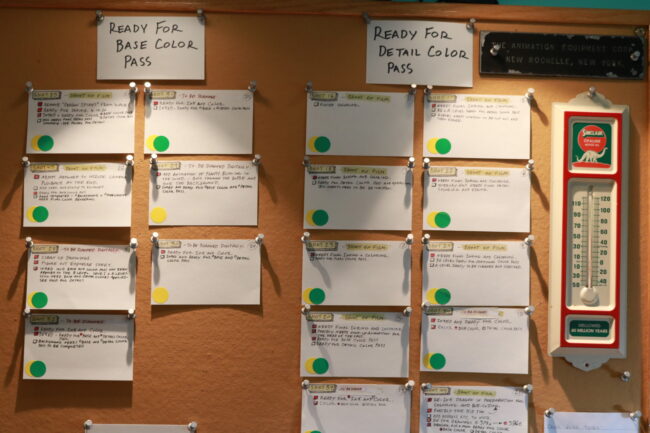
So when are you gonna finish it?
The animation has been completed and now I’m in the process of cleaning up and inking the final artwork and, as I mentioned, I’ve been hiring a small crew to help with the color rendering.
I’ve seen pictures of young animators [on social media].
Yep. So I’m having each of them track how long it’s taking to complete a specific phase of each shot they are working on (the entire film is being rendered with colored pencils so each drawing can require multiple color passes to complete). Once I have everything inked, I will take the information Rendering Artists have compiled (which also includes the number of drawings and layers and the field sizes) for their shots and extrapolate how many more people-hours it’s going to take to finish coloring the remaining shots.
Then I’ll probably revisit the budget before doing the final big fundraising push and, depending on how much money I am able to raise, I will then know how long it’s going to take me to finish Dear Anna Olson.
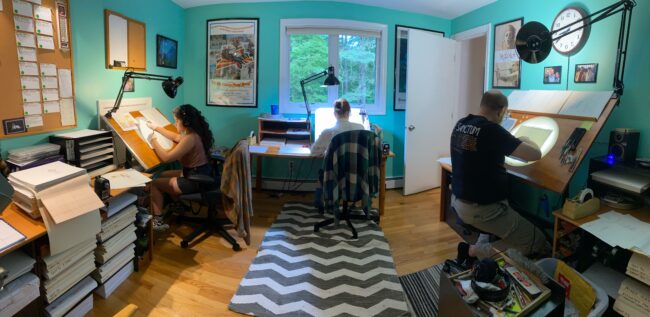
Left to right: Alex Gutierrez, Elyse Kassa & Me – Summer 2023
Your commitment to your art and the art of animation, is impressive to say the least. And I just want to say, I think we’re all very much looking forward to the premiere.
Me too!
Anything we missed? Should I plug your website to raise funds?
Yes, and we’re tax deductible!
Ok, I will be sure to add a link to:
Interviewers note: I was able to view the work in progress and have to say that it’s a tour de force of independent animation. Dean’s combination of storytelling, draftsmanship, film language and the possibilities of animation is awe inspiring.

